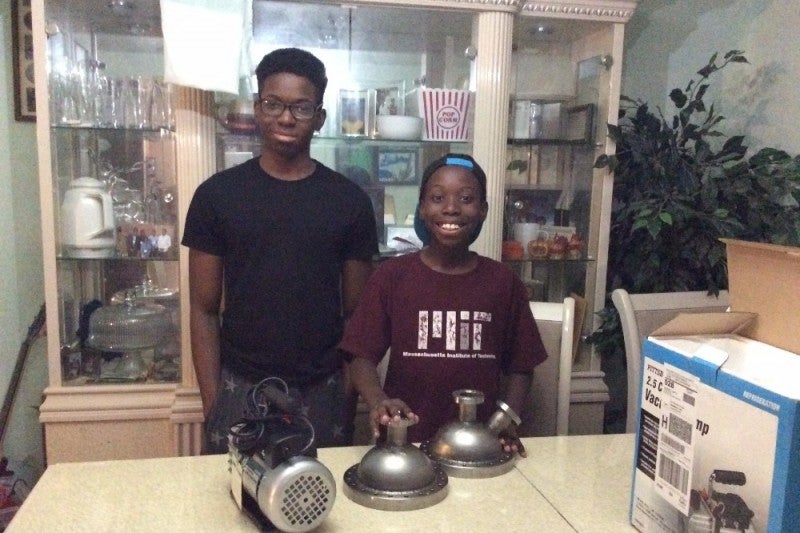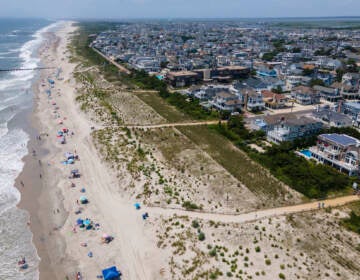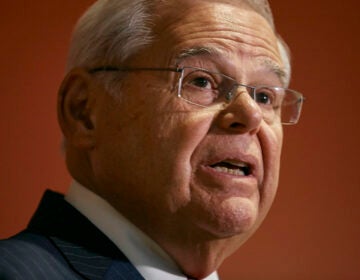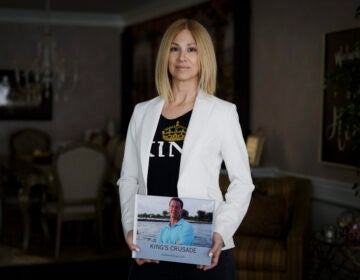South Jersey teen’s love of science leads him to build nuclear fusor…in his basement
Listen
Steven Udotong (left), 16 of Cinnaminson, New Jersey, is building a nuclear fusor in his home. Steven, pictured with his 11-year-old brother, Tony, has raised nearly $3,000 to build the device. (Steven Udotong/GoFundMe)
At the Princeton Plasma Physics Laboratory, not far from the campus of the Ivy League university, physicist and Princeton professor Andrew Zwicker recently showed Steven Udotong a professional version of the project the youth is working on at home.
“This isn’t plasma, is it?” said 16-year-old Steven.
“It is,” Zwicker answered, moving a lever on the metal machine in the lobby of the building. The lever moves the pink, neonlike light inside of the box, stretching the plasma like taffy.
“So you haven’t made a plasma, yet?”
Steven, who was at the PPPL with his mother, Nonye, and his 11-year-old brother, Tony, is junior at Cinnaminson High School. He is not your typical teenager.
From an early age, he’s harbored a deep love of science and math, particularly physics.
“I’ve always been interested in science,” he said. “I dream about being in a lab, just working on anything. Biology. Chemistry. Astrophysics. It was always the field of science for me.”
Steven’s interest in science has driven him to chase a new goal: He’s building a nuclear fuser in his South Jersey home.
What exactly is a nuclear fusor, you ask?
“A nuclear fusor is a machine that fuses two isotopes of hydrogen together forming helium and neutrons in a reaction,” Steven explained. “Nuclear” often generates thoughts of radiation, instability, and lead suits. However, that type of nuclear energy is created by fission.
Energy from fusion, which is also what the PPPL is using in its work, is different and safer for a key reason.
“We don’t produce long-lived radiation,” Zwicker said. “There’s no concerns around any of the safety hazards that happen with a fission power plant.”
So, while Steven must be careful while building and operating the fusor — such as using some basic shielding — he’s convinced his mother it’s safe to put together at home. His interest was sparked when nuclear energy came up as a topic in a science class.
“I grew interested in building one in my sophomore year of high school as we went over the topic of nuclear science, and I began researching online if I could do anything at home,” he said. “I soon discovered I could do a DIY nuclear fusor.”
An entire community of scientists of all ages is trying to build fusors. While a lot of teens are spending their time on Facebook or Twitter, Steven often goes on fusor.net, an online outlet for students, professors, and everyday people who love working with fusion.
But few, however, are taking the aggressive approach of Steven.
Science runs in his family
Steven is not the first in his family to have a serious love of science and math. It practically runs in his bloodlines.
His grandfather is an engineer.
His father, Isaac, is an engineer.
His oldest brother, Sam, graduated from MIT and currently works for a computer startup in California. Two other brothers — Isaiah and Emmanuel — are attending MIT and Princeton respectively. Both are majoring in engineering.
Steven’s mother, Nonye, immigrated to the U.S. from Nigeria more than 20 years ago. A physicist, she has previously taught at Rowan University.
Building the fusor is not an issue for her.
“I really just wanted to make sure it was something he wanted to do because that was going to be a lot of commitment on his time, on his intellect,” she said, as her son toured the PPPL. “Being able to do the theoretical work.”
This is also not Steven’s first project. His father has often encouraged his creativity with challenging projects.
“I think when I was young and maybe middle school or so, I worked with my dad to build a type of radio with a small science kit,” Steven said. “I think it was an FM radio.”
He’s able to find fuser components online through eBay and other sites that sell vacuum parts and wire mesh.
The fusor also runs up steep electric bills. All told, Steven and his mom have spent more than $3,000 on this project. And a GoFundMe campaign led by Steven’s older brothers has raised nearly $2,500 more.
“You would say it’s a lot of money, but it’s really not bad compared to other people who’ve spent money on this,” Steven said. “Some people have spent upwards of $10,000 because they’ve rushed, and they haven’t looked carefully for parts they can find.”
‘A family of stars’
Steven caught the attention of Zwicker, who is also a New Jersey Assemblyman, during a scholarship banquet in South Jersey honoring one of Steven’s brothers. Zwicker sees something special in the Udotongs.
“Wow, this is a family of just stars. These are the rocket scientists,” he said. “The next generation that’s going to save the planet.”
He was happy to invite Steven and his mom up to Princeton to tour the PPPL. As an advocate for STEM programs, Zwicker said he sees kids like Steven as proof of what happens when a premium is put on math and science.
The federal Department of Education projects that careers in science, technology, engineering and math will go up across the board — particularly in engineering. That means students like the Udotongs are ahead of the curve.
“This is a trend because this is where innovation happens,” Zwicker said. “This is where we get to discover the cure for cancer or the next form of energy.”
Steven hopes to finish the fusor this summer. He doesn’t shy away from being an inspiration to other African-American teens who are interested in math and science classes.
“I hope to be a source of inspiration,” he said. “I’m hoping that they can see that this is another way to success that we can have.
“We don’t have to follow other people,” he added, “and find success though sports or music.”
As for his future plans, he’s was accepted to Yale’s Young Scholars program last year and he has already started looking at colleges a year before he graduates.
He’s applied to Carnegie-Mellon, Yale, Harvard, and — of course — Princeton, where he appears to have a spot in the PPPL Lab waiting on him.
“Steven doesn’t have to go to Princeton to be here, but I’m counting on Steven one day being here and helping us to make sure that we can bring fusion energy to all of humanity,” Zwicker said. “We need the next generation to do that, and Steven’s going to be leading that. Is that a promise Steven?”
Steven looked up, nonchalantly smiled and answered, “That is a promise.”
WHYY is your source for fact-based, in-depth journalism and information. As a nonprofit organization, we rely on financial support from readers like you. Please give today.




